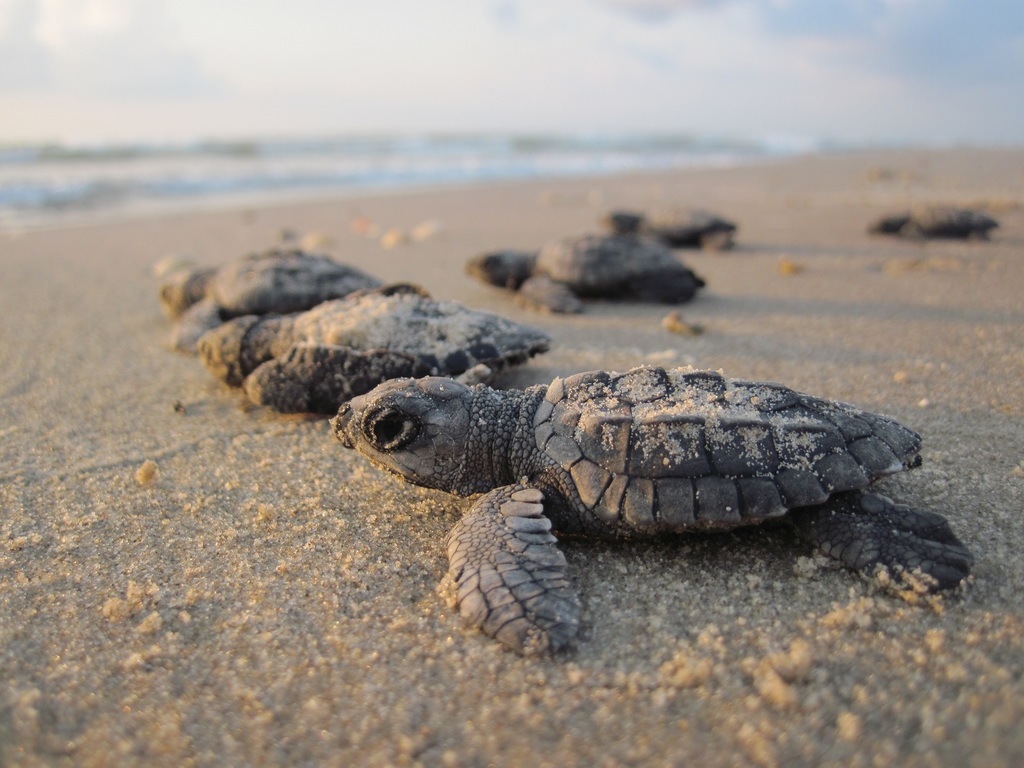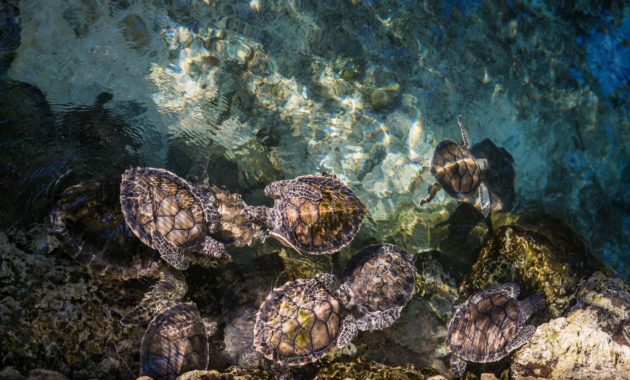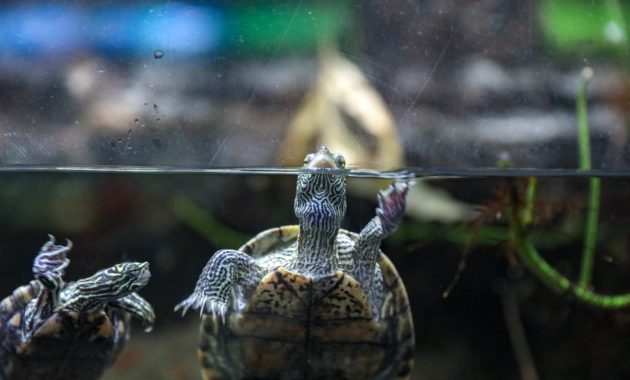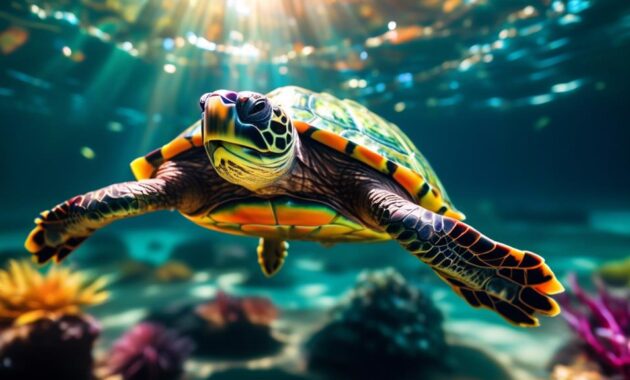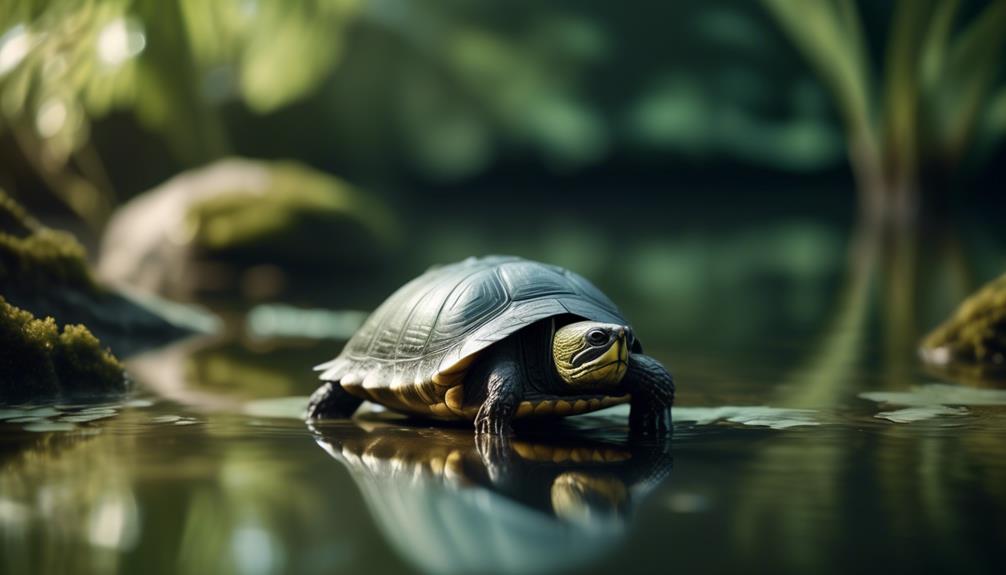
Welcome to the fascinating world of the Caspian Pond Turtle, where you will uncover the secrets of this intriguing creature.
Imagine observing a small turtle, with its unique characteristics and behaviors, gracefully navigating its way through its diverse habitats.
From its adaptable nature to its captivating appearance, the Caspian Pond Turtle holds many surprises waiting to be discovered.
But what exactly makes this turtle so fascinating? Let's dive in and explore the wonders of the Caspian Pond Turtle together.
Key Takeaways
- The Caspian Pond Turtle has an average lifespan of over 40 years and measures around 7 to 9 inches in length, making it a suitable choice for those seeking a pet turtle that won't take up too much space.
- This species is highly adaptable and can thrive in various habitats, including brackish and freshwater bodies of water. It can also become dormant in mud during summer and hibernate in northern areas during winter.
- The Caspian Pond Turtle has a striking appearance with unique patterns on its shell, head, and arms. It breeds in spring and sometimes autumn, laying a clutch of 4-6 eggs.
- Juveniles of this turtle species are carnivorous, feeding on insects, worms, and snails, while adults are omnivorous, consuming aquatic vegetation, algae, fruits, berries, small fish, tadpoles, and crustaceans. Their diverse and adaptable diet allows them to thrive in various environments.
Size and Lifespan
The Caspian Pond Turtle is small in size and has an average lifespan of over 40 years. These turtles are known for their longevity, and with proper care, they can live even longer. They typically measure around 7 to 9 inches in length, making them a perfect choice for those seeking a pet turtle that won't take up too much space.
Despite their small size, these turtles are hardy and adaptable, able to thrive in various habitats. Whether you choose to keep them in a tank or a pond, they'll bring joy and fascination to your life for many years to come.
Native Habitat
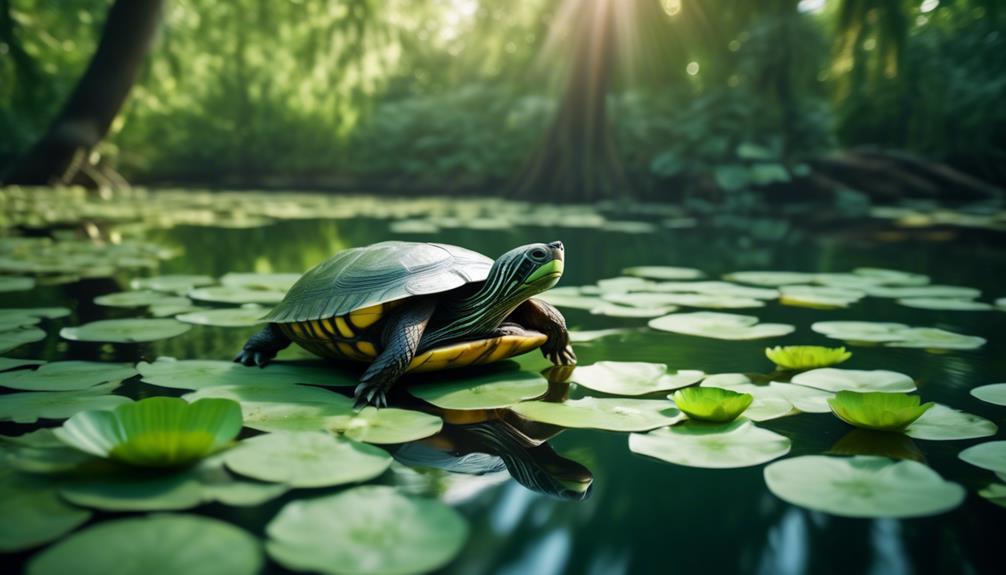
With its adaptable nature and ability to thrive in various countries, the Caspian Pond Turtle is found in diverse habitats across Saudi Arabia, Israel, Iran, Eastern Europe, Turkey, Crete, Cypress, Yugoslavia, and Bulgaria. In these habitats, the Caspian Pond Turtle exhibits some interesting behaviors and adaptations:
- Highly adaptable to brackish and freshwater bodies of water
- Can become dormant in mud during summer in temporary water areas
- Turtles in northern areas hibernate during winter
- Prefers areas with ample vegetation for cover and foraging
These adaptations allow the Caspian Pond Turtle to survive and thrive in a range of environments, from hot and dry regions to cooler climates.
Whether it's brackish marshes or freshwater ponds, this species has found a way to make these diverse habitats its home.
Overall Description
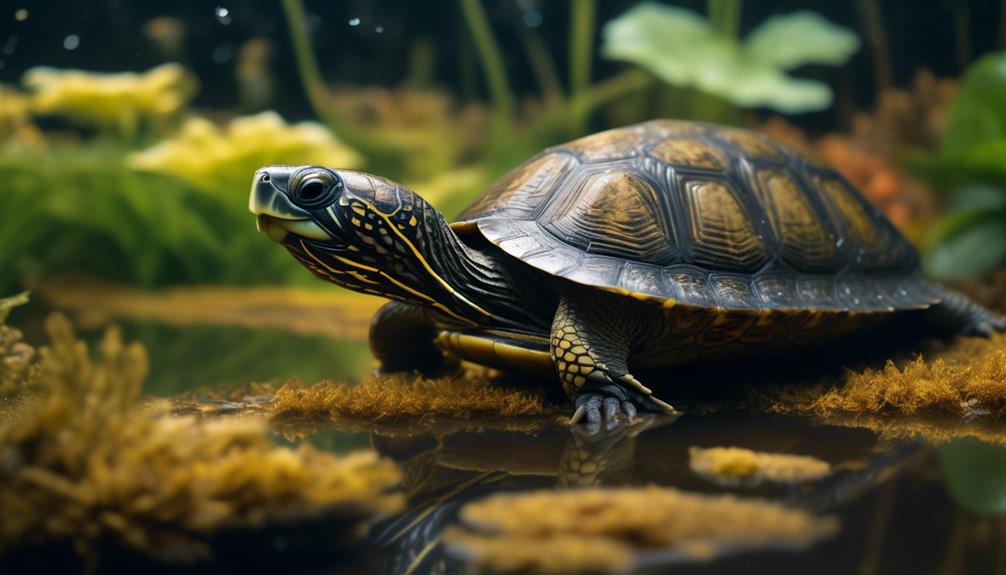
What makes the Caspian Pond Turtle stand out in its appearance? The Caspian Pond Turtle has an oval and smooth carapace that can come in black, tan, or olive color. It is marked with cream or yellow lines, adding to its unique look. This turtle breeds in the spring and sometimes in the autumn, with a clutch size of 4-6 brittle-shelled, elongated, white eggs. Juveniles are carnivorous, while adults are omnivorous. The carapace of the Caspian Pond Turtle can be tan, black, or olive in color, with yellow or cream-colored patterns on its shell, head, and arms. This striking appearance makes the Caspian Pond Turtle a truly fascinating sight to behold.
| Characteristics | Appearance |
|---|---|
| Carapace Color | Tan, Black, Olive |
| Pattern Color | Yellow, Cream |
| Breeding Season | Spring, Autumn |
| Clutch Size | 4-6 eggs |
| Diet | Carnivorous (Juveniles), Omnivorous (Adults) |
Colors
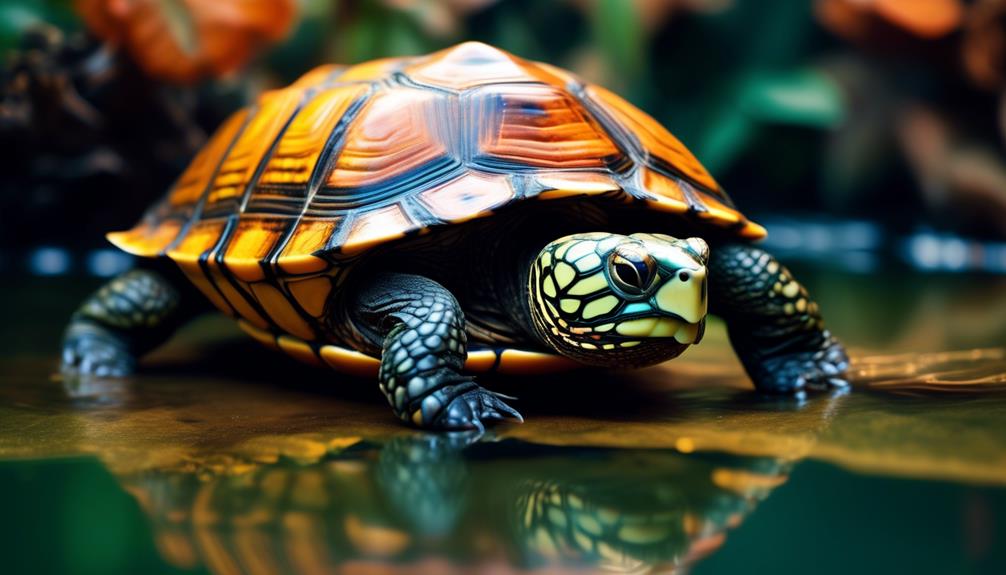
The Caspian Pond Turtle exhibits a stunning array of colors, with its carapace ranging from tan to black or olive, and its shell, head, and arms adorned with beautiful yellow or cream patterns. This vibrant coloration adds to the turtle's allure and makes it a visually striking species.
The different color variations can be attributed to genetic factors and environmental influences. Here are some interesting facts about the colors of the Caspian Pond Turtle:
- The carapace can be tan, black, or olive in color.
- The shell, head, and arms are often marked with yellow or cream colored patterns.
- The coloration helps the turtle blend in with its surroundings, providing camouflage and protection.
- The bright colors also play a role in courtship displays, with males using their vibrant markings to attract females.
These captivating colors make the Caspian Pond Turtle a truly fascinating creature to observe and appreciate.
Environment and Care Requirements
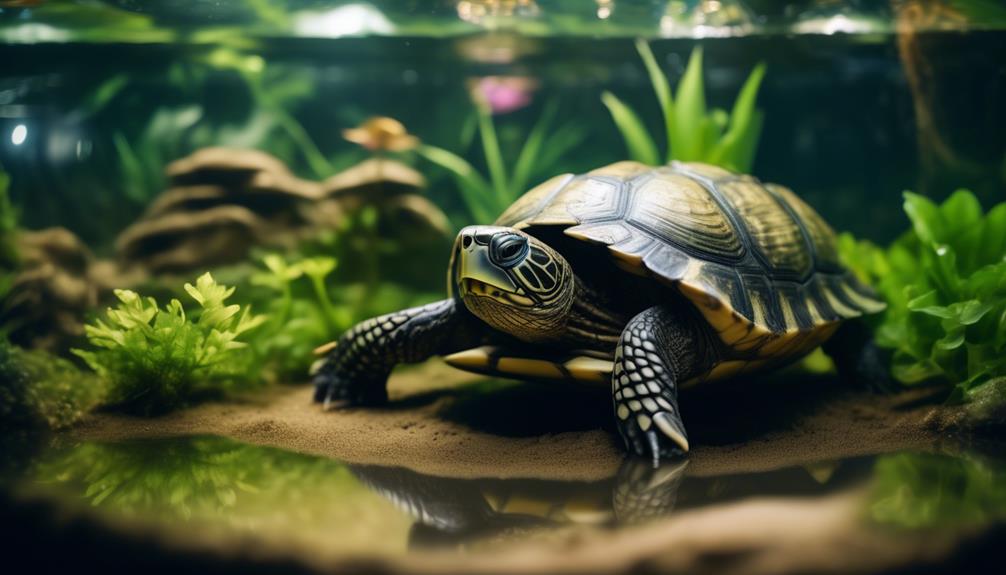
To ensure the well-being of your Caspian Pond Turtle, it is important to provide the appropriate environment and care requirements. Here are some key points to consider:
| Requirement | Description |
|---|---|
| Substrate | – Avoid gravel to prevent waste and food accumulation |
| Basking area | – Provide a dry surface for basking and resting |
| Filtration and lighting | – Use a powerful filter system to maintain cleanliness |
| – Ensure proper UVB lighting for the turtle's health | |
| Temperature | – Water temperature: Maintain between 60°F and 82°F |
| | – Basking area temperature: Keep at 90-100°F
Creating the right environment is crucial for your Caspian Pond Turtle's health and happiness. A spacious tank is necessary to accommodate their needs, with a minimum size of 75 gallons for adults, 90 gallons for a pair, and an additional 40 gallons for each additional turtle. Avoid using gravel as substrate to prevent waste and food buildup. Provide a dry surface for basking and resting, and ensure a powerful filtration system for cleanliness. Additionally, proper UVB lighting is essential for their overall well-being. Maintain the water temperature between 60°F and 82°F, and the basking area temperature at 90-100°F.
Breeding and Reproduction
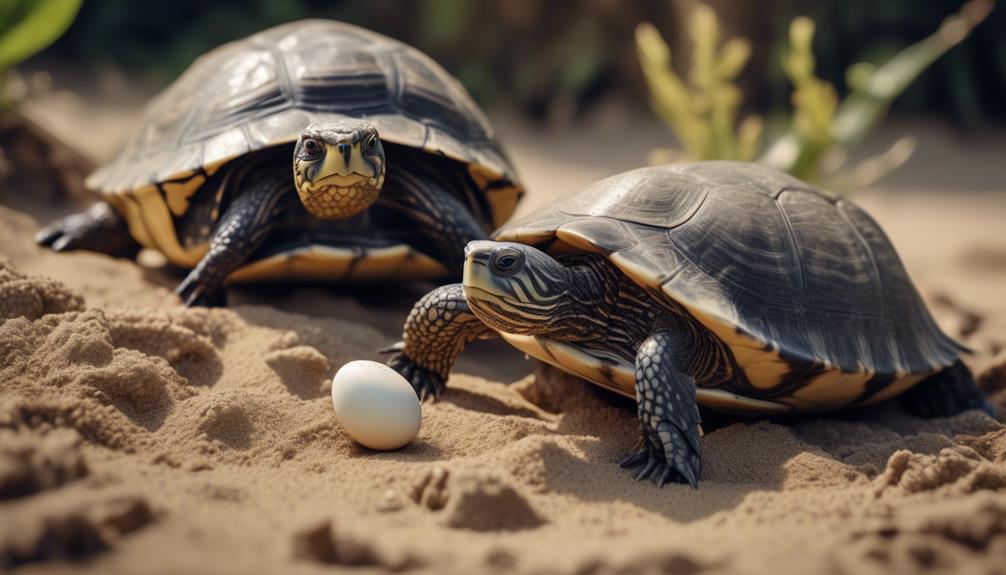
Now let's explore the fascinating world of the Caspian Pond Turtle's breeding and reproduction.
- Breeding Season: The Caspian Pond Turtle breeds in the spring and sometimes in the autumn.
- Clutch Size: The female turtle lays a clutch of 4-6 brittle-shelled, elongated, white eggs.
- Incubation: The eggs are incubated for about 3 months until they hatch into adorable baby turtles.
- Maturation: As juveniles, these turtles are carnivorous, but they become omnivorous as they reach adulthood.
Breeding and reproduction are crucial aspects of the Caspian Pond Turtle's life cycle. Understanding the breeding habits and reproductive patterns of these turtles can help in their conservation and preservation.
Diet and Feeding Habits
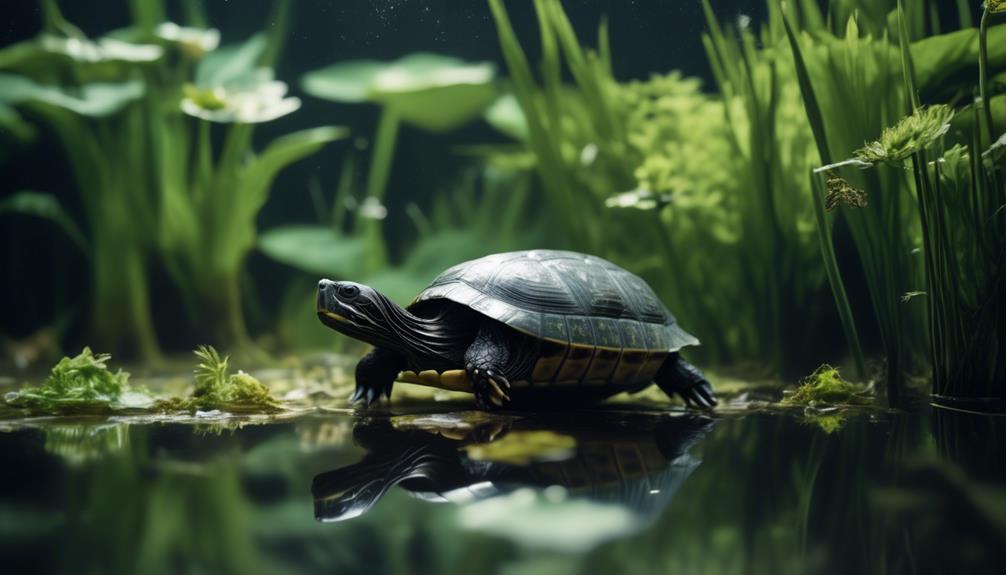
Caspian Pond Turtles have a diverse and adaptable diet, allowing them to thrive in a variety of environments. As juveniles, they're primarily carnivorous, feeding on small invertebrates such as insects, worms, and snails.
As they grow, their diet expands to include a wider range of food sources. Adult Caspian Pond Turtles are omnivorous, consuming both plant matter and animal prey. They commonly feed on aquatic vegetation, algae, fruits, and berries. Additionally, they prey on small fish, tadpoles, and crustaceans.
These turtles have sharp beaks that enable them to tear and chew their food effectively. With their ability to adapt their diet according to their surroundings, Caspian Pond Turtles are well-equipped to find sustenance and thrive in their diverse habitats.
Frequently Asked Questions
Can Caspian Pond Turtles Be Kept as Pets?
Yes, you can keep Caspian Pond Turtles as pets. They are highly adaptable to different water environments and have specific care requirements such as tank size, temperature, and filtration.
Do Caspian Pond Turtles Require a Specific Type of Substrate in Their Tank?
No, Caspian Pond Turtles do not require a specific type of substrate in their tank. It is recommended to avoid gravel to prevent waste build-up. Provide a dry surface for basking and resting.
What Is the Average Size of a Fully Grown Caspian Pond Turtle?
The average size of a fully grown Caspian Pond Turtle is small. They have an oval and smooth carapace in black, tan, or olive color, and can be marked with cream or yellow lines.
Are Caspian Pond Turtles Social Animals That Should Be Kept in Groups?
No, Caspian Pond Turtles are not social animals that should be kept in groups. They prefer to live alone and do not require the company of other turtles for their well-being.
Can Caspian Pond Turtles Be Kept in Outdoor Ponds or Do They Require an Indoor Tank Setup?
You can keep Caspian Pond Turtles in outdoor ponds as long as the conditions are suitable. However, they can also be kept in an indoor tank setup with the right size, temperature, and lighting.
Are Caspian Pond Turtles and North American Wood Turtles Related in Any Way?
Yes, Caspian Pond Turtles and the fascinating North American Wood Turtle are both members of the family Emydidae, which makes them somewhat related. However, their habitats and physical characteristics differ significantly, so they are not closely related species. Both are intriguing creatures in their own right.
Conclusion
Now that you have explored the captivating world of the Caspian Pond Turtle, you have gained insight into its unique characteristics and needs.
From its small size and long lifespan to its adaptable nature and striking appearance, this turtle is truly fascinating.
By providing them with the proper care and environment, we can ensure the well-being of these remarkable creatures for years to come.
So, join us in cherishing and protecting the incredible Caspian Pond Turtle!

